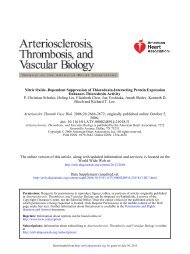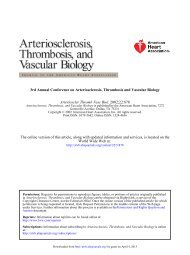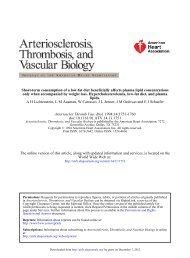CX3CR1 Deficiency Confers Protection From Intimal Hyperplasia ...
CX3CR1 Deficiency Confers Protection From Intimal Hyperplasia ...
CX3CR1 Deficiency Confers Protection From Intimal Hyperplasia ...
Create successful ePaper yourself
Turn your PDF publications into a flip-book with our unique Google optimized e-Paper software.
2060 Arterioscler Thromb Vasc Biol. September 2006<br />
model, platelets and neutrophils cover the denuded luminal<br />
surface within 24 hours. 22–24 The area of platelet accumulation<br />
was unaffected by the absence of CX 3CR1. Likewise, no<br />
significant differences were observed in shear-induced platelet<br />
thrombus formation in blood from WT and CX 3CR1deficient<br />
mice. These results suggest that platelet CX 3CR1<br />
does not play a major role in the initial phases of platelet<br />
adhesion and aggregation stimulated by the vascular injury.<br />
Likewise, CX 3CL1 was not highly expressed within the first<br />
24 hours after injury. Whether CX 3CR1 contributes to other<br />
platelet responses cannot be determined from our study.<br />
Regenerated endothelial cells expressed high levels of<br />
CX 3CL1. Similar to previous reports, 22 we observed regeneration<br />
of endothelial cells within 5 days of arterial injury.<br />
The endothelium before injury did not express CX 3CL1, but<br />
the regenerated endothelium expressed high levels of<br />
CX 3CL1. In contrast to WT animals that had robust monocyte<br />
accumulation, CX 3CR1 / mice failed to recruit monocytes to<br />
the intima despite expression of CX 3CL1. Interestingly,<br />
monocytes accumulated in the adventitia of WT and<br />
CX 3CR1 / animals after injury, suggesting that monocyte<br />
recruitment to the adventitia may occur through mechanisms<br />
distinct from those required for intimal recruitment. A primary<br />
difference between these two sites is the presence of<br />
arterial shear forces, and monocyte capture and transmigration<br />
along the artery may require CX 3CR1-driven adhesion<br />
and/or migration to resist the shear. In contrast, recruitment of<br />
Figure 5. CX 3CR1 effect on monocyte<br />
adhesion. Monocyte recruitment to<br />
injured vessels in vivo was tested by<br />
immunohistochemical staining of F4/80<br />
antigen (A, B) and adhesion to CX3CL1<br />
in vitro was tested by the parallel plate<br />
flow chamber adhesion assay using<br />
splenocytes from WT and CX 3CR1 /<br />
mice (C). A, Monocyte staining (brown) in<br />
injured WT and CX 3CR1 / arteries at 5<br />
days after surgery. B, Average number of<br />
monocytes in the intima of WT and<br />
CX 3CR1 / (KO) arteries 5 days after<br />
injury (n16). Results are expressed as<br />
the meanSEM. **P0.05. C, Average<br />
number of Moma2-FITC monocytes<br />
bound to CX 3CL1. Results are expressed<br />
as the meanSEM. **P0.05.<br />
tissue macrophages or transvenous migration of monocyte to<br />
the adventitia may occur by CX 3CR1-independent mechanisms.<br />
While we cannot exclude the possibility that adventitial<br />
macrophages traffic and migrate toward soluble CX 3CL1<br />
through the vessel wall to the luminal surface, the data<br />
support a primary role for CX 3CR1 in the rapid capture and<br />
firm adhesion of monocytes under flow conditions. 14 Clinical<br />
cohorts have shown that 2 single nucleotide polymorphisms<br />
of CX 3CR1, V249I and T280M, are associated with reduced<br />
prevalence of atherosclerosis and coronary artery disease. 8,9<br />
In addition, the M280 allele is associated with a reduced risk<br />
of internal carotid artery (ICA) occlusive disease. 10 Our<br />
laboratory has shown that the protein encoded by the M280<br />
allele has impaired adhesive capacity, 7 suggesting that cell<br />
adhesion is an important mechanism by which CX 3CR1<br />
exerts its effect on recruiting cells during vascular<br />
inflammation.<br />
In addition to CX 3CR1, CCR2 appears to mediate the<br />
response to arterial injury as well. In the same mouse model<br />
of wire-induced femoral artery injury, CCR2 / mice had a<br />
phenotype comparable to CX 3CR1 / mice in terms of a<br />
reduced intimal hyperplasia and intima/media ratio 4 weeks<br />
after injury. 23 In the CCR2 study, no macrophage infiltration<br />
was seen by MOMA-2 or CD68 staining in either WT or<br />
CCR2 / animals and the authors concluded that CCR2 did<br />
not affect macrophage accumulation within the arterial wall<br />
after injury. Although both CX 3CR1 and CCR2 mediate<br />
Downloaded from<br />
http://atvb.ahajournals.org/ by guest on March 25, 2013<br />
Figure 6. VSMC proliferation in response to vascular<br />
injury. Shown is the proliferation of VSMCs in<br />
the intima and media of injured WT and <strong>CX3CR1</strong> /<br />
arteries at 5 and 14 days after injury. Proliferating<br />
VSMCs were defined as those -actin positive<br />
cells that were BrdU (d5) or PCNA (d14) positive.<br />
Results are represented as meanSEM. *P0.07,<br />
**P0.03.














